Dark Nights: Metal do-over... where the bad guys win, in new Tales from the Dark Multiverse special
What if Dark Nights: Metal ended with the bad guys in charge? Well, in this special it does
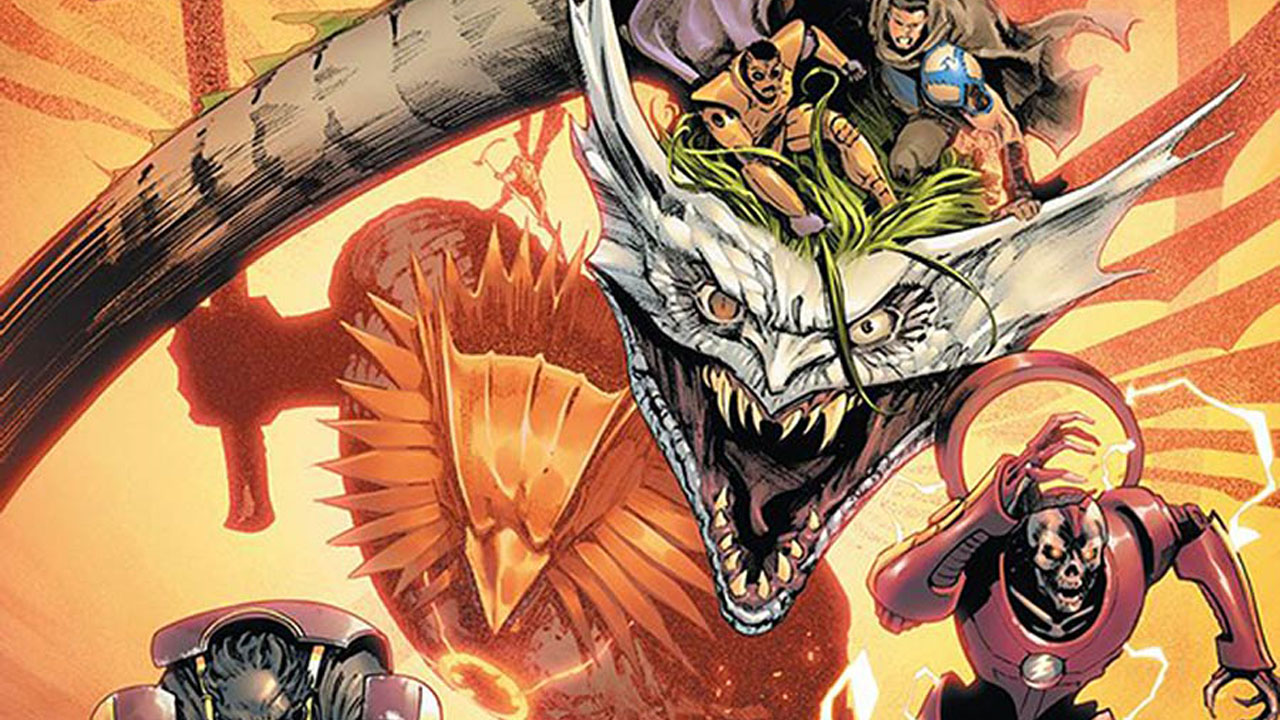
The current DC event Dark Nights: Death Metal is a massive sequel to the original 2017-2018 Dark Nights: Metal event, but next week readers can witness another unique spin on that big event - where the bad guys win.
December 29's Tales from the Dark Multiverse: Metal one-shot revisits that event and what would've happened if the Justice League hadn't beaten Barbatos. First up, those DC heroes become 50-foot-tall dragons.
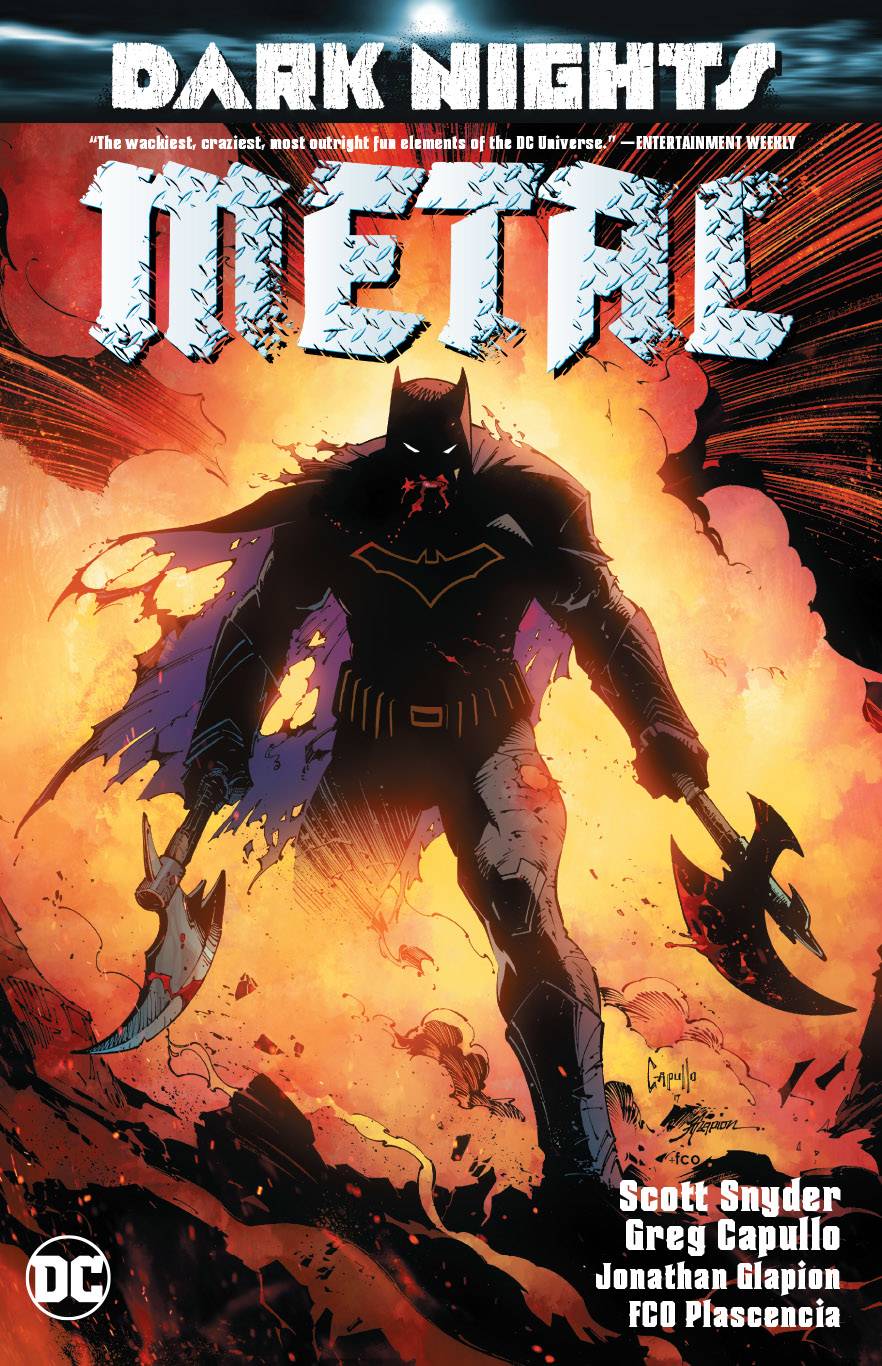
Yep, it's wild.
In this dark, twisted version of Metal, it's up to a new team of heroes - led by Duke Thomas/The Signal - to find the light in this proverbial dark abyss.
Writers Jackson Lanzing and Collin Kelly describe Tales from the Dark Multiverse: Metal as a virtual guitar solo on every page, and even got some proverbial guest-shredding some Metal's original writer/co-creator Scott Snyder. Newsarama spoke to the writing duo about this encore to the original Metal, developing some wild ideas for what the bad guys would do if they won, and how they worked alongside Snyder while he writes the sequel, Dark Nights: Death Metal.
Newsarama: Jackson, Collin, how did Tales From the Dark Multiverse: Metal come about?
Jackson Lanzing: It was the first time since Batman & Robin Eternal that we just got a straight offer to come in and have some fun at DC. Dark Multiverse has been an initiative we've been excited about for a long time, and we've been talking to our editors in the Bat office about where we might fit in there.
Get the best comic news, insights, opinions, analysis and more!
Finally, we just got a call. It was like, 'Look, it's Metal. It's time to go. Totally bud nuts with a story we need absolute chaos, energy. Want to come in and just guitar solo all over the place for 48 pages?' And we were delighted. Then they told us that Scott was going to get in the boat with us and it was like insane that we were just so excited. That's effectively how it came about. Like then we kind of went to our corners and started.
Nrama: What made you want to work on an alt-version of Dark Nights: Metal in particular?
Lanzing: Metal was the offer, and weirdly not Death Metal, which is an easy way to be confused because it's coming out on the same day as all of this Death Metal content. But this is actually Tales from the Dark Multiverse: Metal. This is the OG original event remastered, reframed, and totally rebuilt as a Dark Multiverse story.
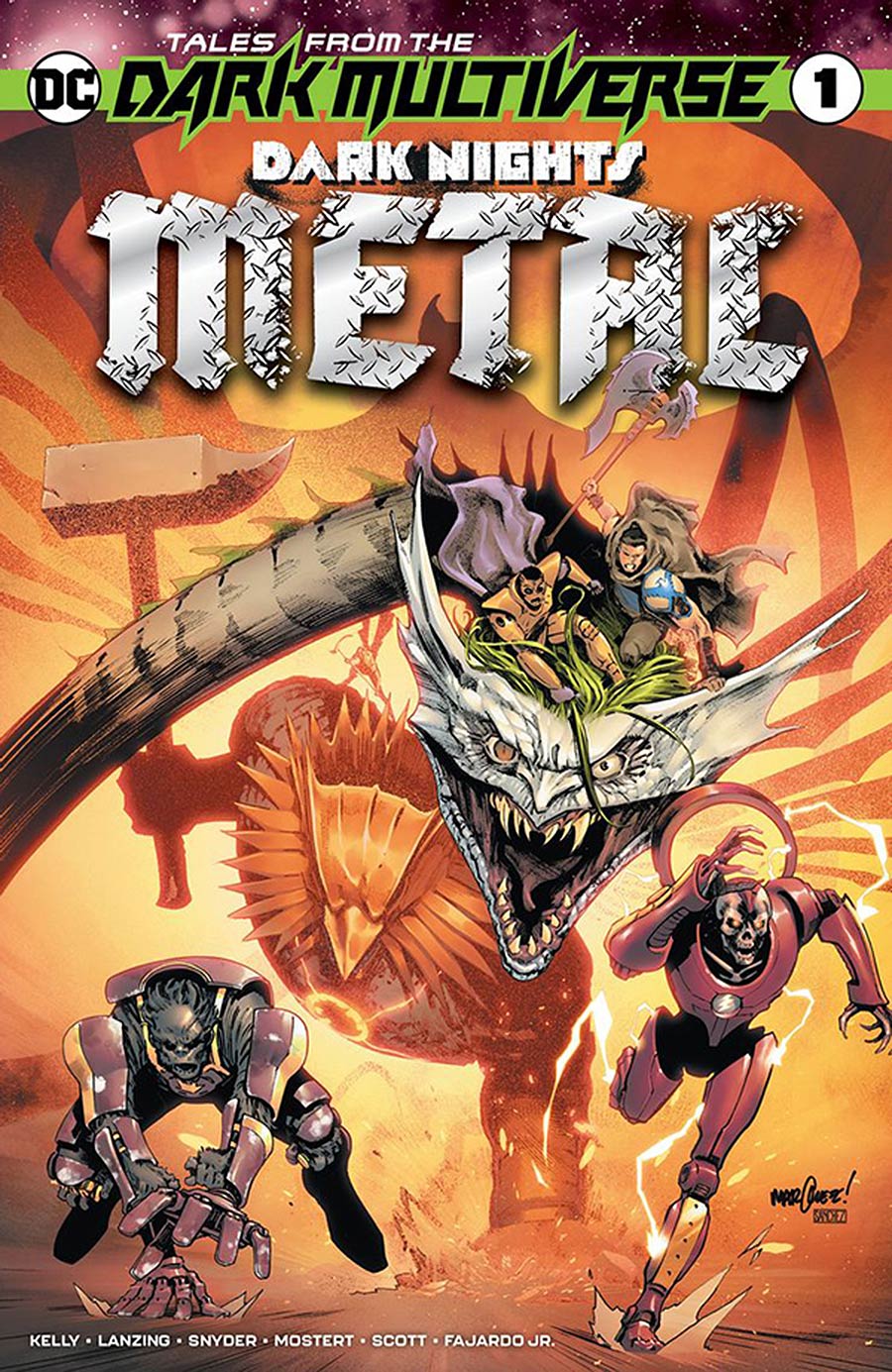
The idea being that for fans of the original Metal, if you wanted to go back and revisit that event and see what might've happened if instead of the heroes pulling together at the end with the Element X armor to beat back Barbatos, the bat dragon. What if instead, Barbatos was one step ahead? Use that armor to corrupt the Justice League, turn them into 80-foot-tall dragons of Barbatos' own design, and then use them to conquer the multiverse.
Our story is once that happened, once the end has come, what does it mean to be a hero? What does it mean to be one of the last people left in that world? So, we follow a small group of individuals who were important to that first Metal event - people like Nightwing, Hawkgirl, Detective Chimp, and most importantly Duke Thomas. Who's been such a core part of Scott's entire Bat saga.
We thought that was really great opportunity to center Duke to put him at the forefront of this story and to use everything about that character from his meta powers, to his background, to his affinity for Bruce Wayne, but also his lack of Robin hood as it were. It was to find a way to turn him into sort of the ultimate version of himself to give him his big heroic climax.
We threw that whole mess at Scott and said like, 'What do you think about this? We went and wrote a whole new song. Do you dig it?' Scott had just been an absolute champion for the project, has been so supportive, and has really been just incredibly gracious with his story, his and Greg Capullo's original event, and let us go totally wild on it, which has been truthfully been one of most humbling and gratifying experiences of our time at DC. To get the trust of such a titan and to get to work with him to put together something so strange, so heartfelt, and frankly something so personal.
By the end of it, we get to something that is very much about what it's been like to go through 2020, and feel like it's hopeless... but hope that there's something on the other side of that if we can only fight through it. So, that's a lot, but that's effectively where the project's genesis was - what it's become and what it's been like working with Scott.
Nrama: Tell us more about that collaboration with Scott, who worked with you while also writing Dark Nights: Death Metal.

Lanzing: Scott is busy. I mean he's a man with many plans. He just launched a creator-owned book and all this other stuff. Our goal was to take up as little of his time as possible, but make sure that he got his voice because it's his event.
So, what we did was we started off by sending some emails, we got the sign off from him pretty quickly in terms of where we wanted to go. Then from there, it was really just a matter of Scott chiming in when he felt like that was a necessary moment. What it felt like on our side was we felt very protected. We felt like within the framework of Metal, which can be a very big and very scary framework. Scott was there to make sure that we didn't step too far to one side or fall off the cliff of continuity.
I don't know how he balances the sheer amount of continuity that he incorporates into his books and especially in Metal, which is high-grade, weapons-grade continuity. I mean it's just all over the place. Our intention was not to cover that - we couldn't, we can't do what Scott does. We do what we do, which is to take characters and really foregrounded as far to the front as we can make it, make it as personal as we can, and then cover it in as much of that continuity weirdness as we can get away with it because we love that stuff.
I thought it was actually kind of a marriage made in heaven because it was a great way to have rails that made a lot of sense and that felt very firm, and then really Collin and I go and do what we do best within a framework that felt very protective.
So, emails back and forth, like mutually supportive 'High-fives you guys are great. We love you!' emails. That was really what the process with Scott was like, which was fantastic. It wasn't our first time collaborating with him. James Tynion IV kind of was the showrunner on Batman & Robin Eternal, and then Scott was the godfather of that book. I like to think of him as like, if it was a TV room, like he was the network, he was the person who really at the end of the day was like, 'Is this going to work?' So, we had known what it was like to work with Scott and to really get into that with him. It was a nice return to that format.
Nrama: Were there plot points from the original Metal you really wanted to turn up to 11?
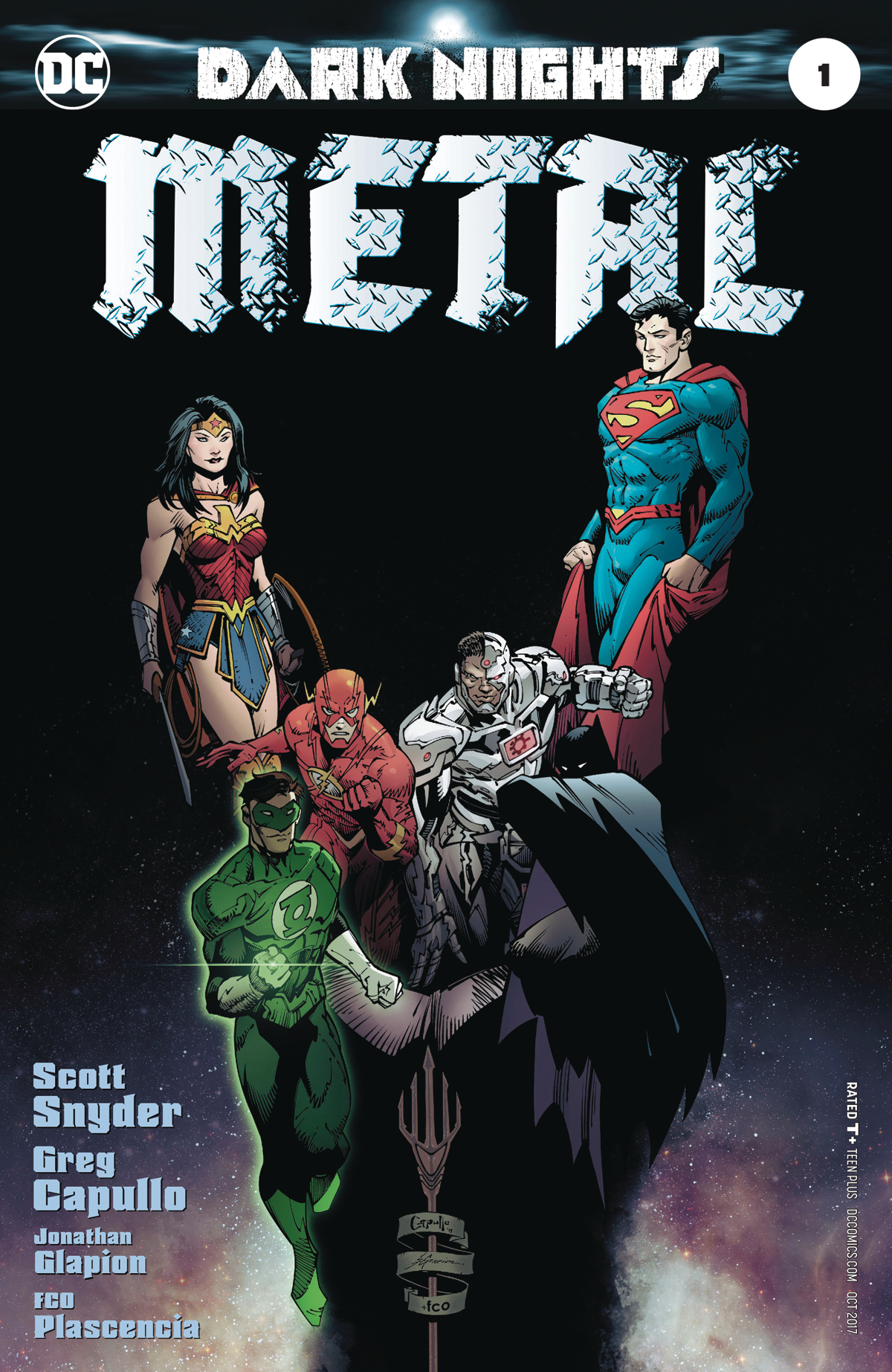
Collin Kelly: One of the first choices we had to make was looking at Metal and asking where did our bifurcation point need to come from? There are so many great points in the story where if you just say, 'Well, if this would have fallen on a slightly different direction everything would have changed.' So, one of our first decisions had to be what point was that for us? What we really found was what we wanted to keep was effectively everything, right?
Metal is a nonstop guitar solo and changing any of it is just a little bit of sacrilege, right? You don't want to change your cover. You got to make sure that you're authentic, the real thing. We wanted to keep was all of Batman's journey, right? This idea that he's created through Barbatos, this tangled knot, this trap that even he may not be able to escape. Obviously, within Metal itself he finds a way, right? He finds this Element X armor that he's been able to use - arm the Justice League and then take the fight directly to the dragon.
That's where we wanted our story to split because Barbatos has always been one step ahead because he is Bruce Wayne and Bruce Wayne is always one step ahead. By effectively making the small change of he got to element X first that armor is corrupted. That's where our story really gets to start. We got to keep effectively all of Metal until the last little tiny bit where we go far afield, and that's where our story starts.
What the bulk of our story is going to do is pick up maybe an indeterminate amount of time later. But once Barbatos's power has really become ascendant he's not only consumed the Earth, but he's begun to consume all Earths - entire multiverses are being pulled into the dark multiverse. This is a launching off point to really tell our own story effectively - a new last chapter to the Metal saga.
Lanzing: It effectively operates as an epilogue to the event that you knew if that had gone the other way. What feels really fun about that is that it means that fans can go back; they can revisit the original Metal. They can read the whole event, and then they can sit down to Tales From the Dark Multiverse: Metal and get this 'What if?' epilogue, that gives them a whole new finale to that book.
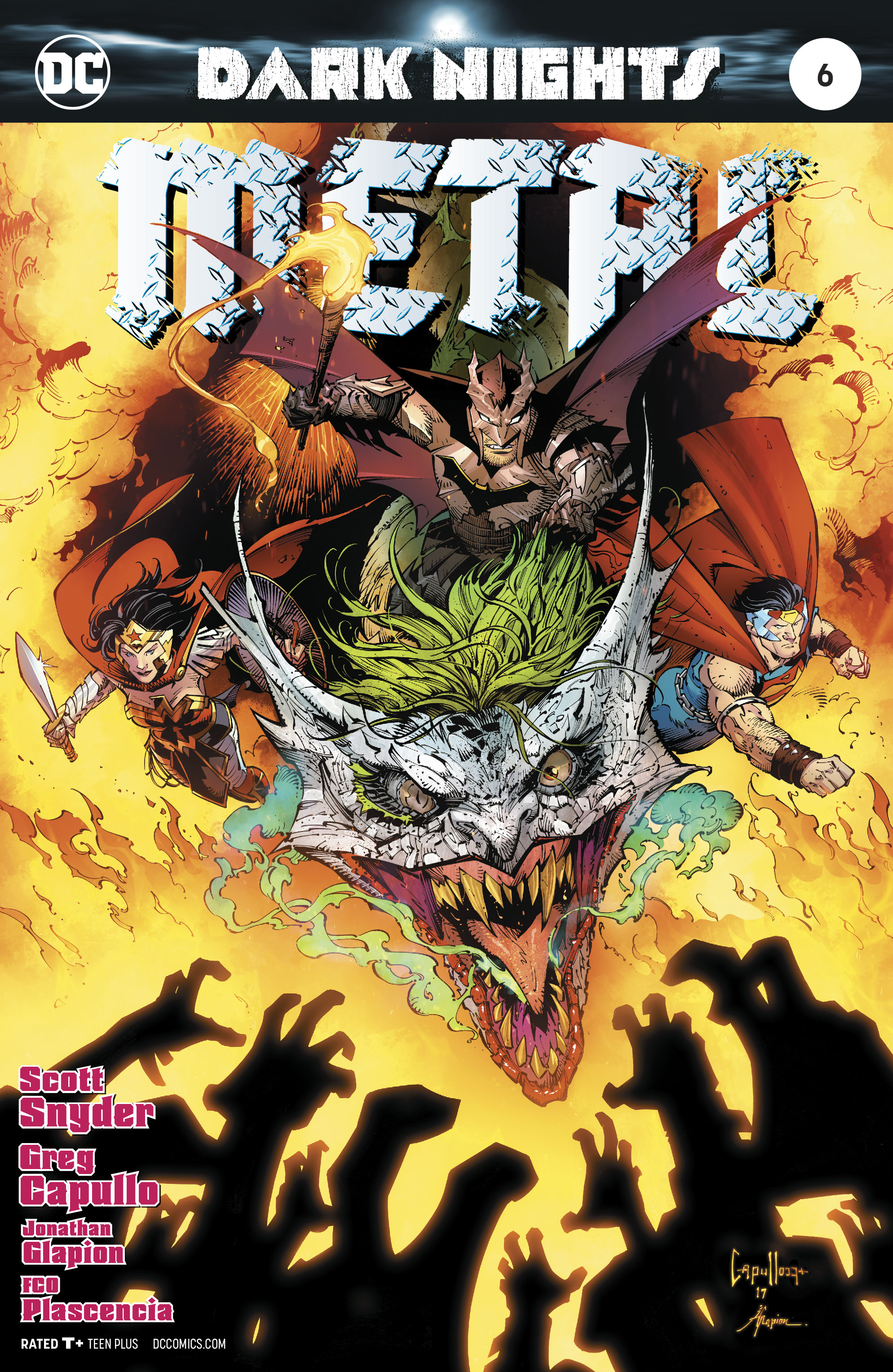
Like what a delightful challenge, reframe the finale of this mega event. It was so intoxicating. Then it's really just about figuring out how do you do that in a way that both honors the original event and also just does everything you want to do. That's where the fun of this really came from, was looking at what characters you want to play with.
Nrama: Many of these Tales From the Dark Multiverse stories have been events from years or even decades ago. What was the process of crafting a divergent take on a story that's so recent and fresh in people's minds?
Lanzing: Intimidating! [laughs] That was a joke answer. Of the time, it felt like something we could really do something with it this year. It's hard to write about 2020. We certainly felt the instinct to jump the gun. It's easy to want to write about how isolating, strange, and hopeless a lot of this year has felt. Halfway through it, we're given this opportunity to revisit a book that is all about hopelessness and finding light in dark places. It's Dark Nights: Metal, right? It's really about looking at how bleak the wider world and the cosmos can be and how you stand up against that even when there's no hope. Fighting hopeless causes is one of our favorite stories.
We didn't think too much about Metal - not in terms of legacy. If we did, we never get started, and I think we never thought too much about Death Metal in part because we didn't want to find ourselves at cross purposes. All we needed to do with Death Metal is know that Death Metal wasn't touching any of the stuff that we were - that it was going in different directions, which thankfully it very much was.
It was really a great chance for us to stake our own claim, figure out our own space, and then do something that felt like it was really honoring that initial event in its tone and its objectives.
Kelly: I also think that one of the exciting things we got to work with was the fact that yes, this wasn't an event from times past, which means the tone was exactly what we wanted to work in. We didn't need to ape one of these kinds of iconic runs from the past. We could tell a story that felt modern and contemporary.
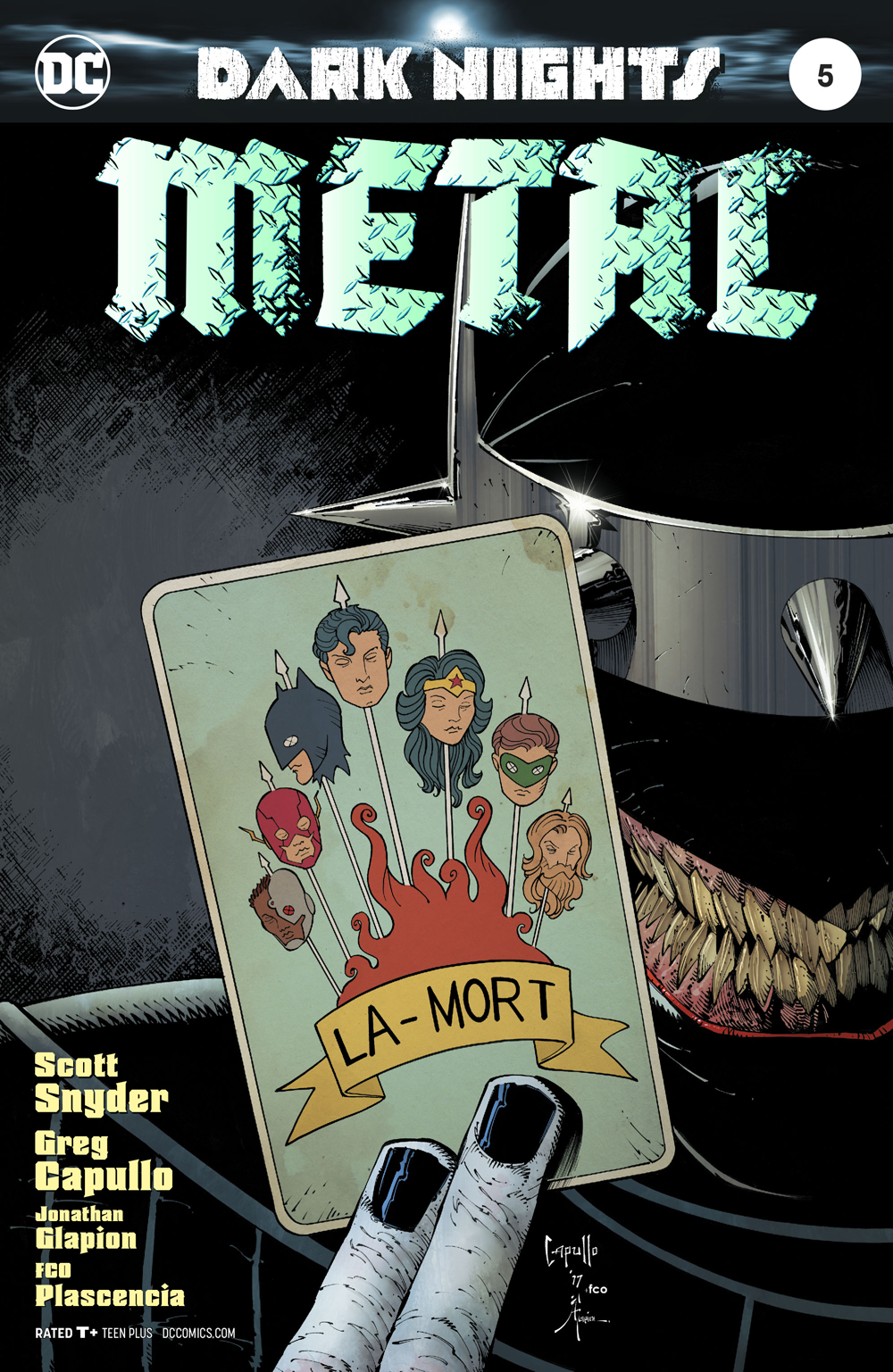
And also fucking Metal. Right? [laughs] That's the cool part - this is not just a classic tale of light in the darkness. This is a rock show. From the very start, that was the mandate. It captured that essence of what Scott and Greg did – damn, which was collect every single page as an absolute jaw-dropping guitar solo, and that was the main gig. That was effectively what we were brought on to do, and I think that's what we achieved if I can say so myself.
Lanzing: That is totally on point. We had a moment pretty quickly scripting where we stopped and went, 'Oh, this is what Metal is - Metal is having the most fun you've ever had writing a book.' Like, it's sitting here and knowing that no answer is too wild, too out there, too continuity based, too - 'goofy' is the wrong word because it makes it sound comedic, but like too goofy. Does Detective Chimp wear Red Tornado's armor as a mecha suit? Hell yeah! Is that going to break the tone? No, you can't break the tone of Metal unless you're not being metal enough. That's hilariously fun to write, like not having a tonal boundary and getting to just be as completely out there as possible.
We emailed Scott and said 'We get it now. Not that we didn't get the original event, but we get why you did this now.' Why wouldn't a writer want to do this? This is the most fun we've ever had. As Collin said, it's like guitar soloing on every single page. There's not a single page that doesn't have something rad on it, and that's rare even in comics where you really strive for them.
Nrama: What was your favorite part about working within the Metal mythos? Any particular plot points you enjoyed from Scott and Greg's run?
Lanzing: I'll start by talking about Duke, and then I'll give literally everything else to Collin. Duke to me was the key to this story, coming from the original Batman run, which I'm just an enormous fan of. Obviously, we worked in the margins of it in Batman & Robin Eternal.
We revisited Metal before we started pitching at each other, talking about what this book might look like. There's a prelude issue - one of the early Metal lead-in books [Dark Days: The Casting] where Duke Thomas and Hal Jordan are in the Batcave, and they discover that Bruce has been keeping secrets there. Among other things, they discover the sort of Batman machine that Bruce had.
It all gets deep into Scott's mythos, but the real discovery of that issue is that Duke realizes that he has meta powers that Batman has been aware of and is sensibly the reason that Batman has been raising him differently than Robin. That he'd been prepping him to become the Signal, which he has this power. The power is sort of an interesting and seemingly kind of passive power, which is that Duke can see things as they were. He can see into the past and see these light constructs that show if a machine used to be somewhere and then it had been disassembled, he could see what the machine looked like. So, if a person changed, the city changed, or if a world change - if a city became a horrible monument to Barbatos or Nightwing became a desert wanderer with very little hope left. He would still see the city of Gotham or Dick Grayson. That is a really wonderful power to have in a world where the heroes have lost.
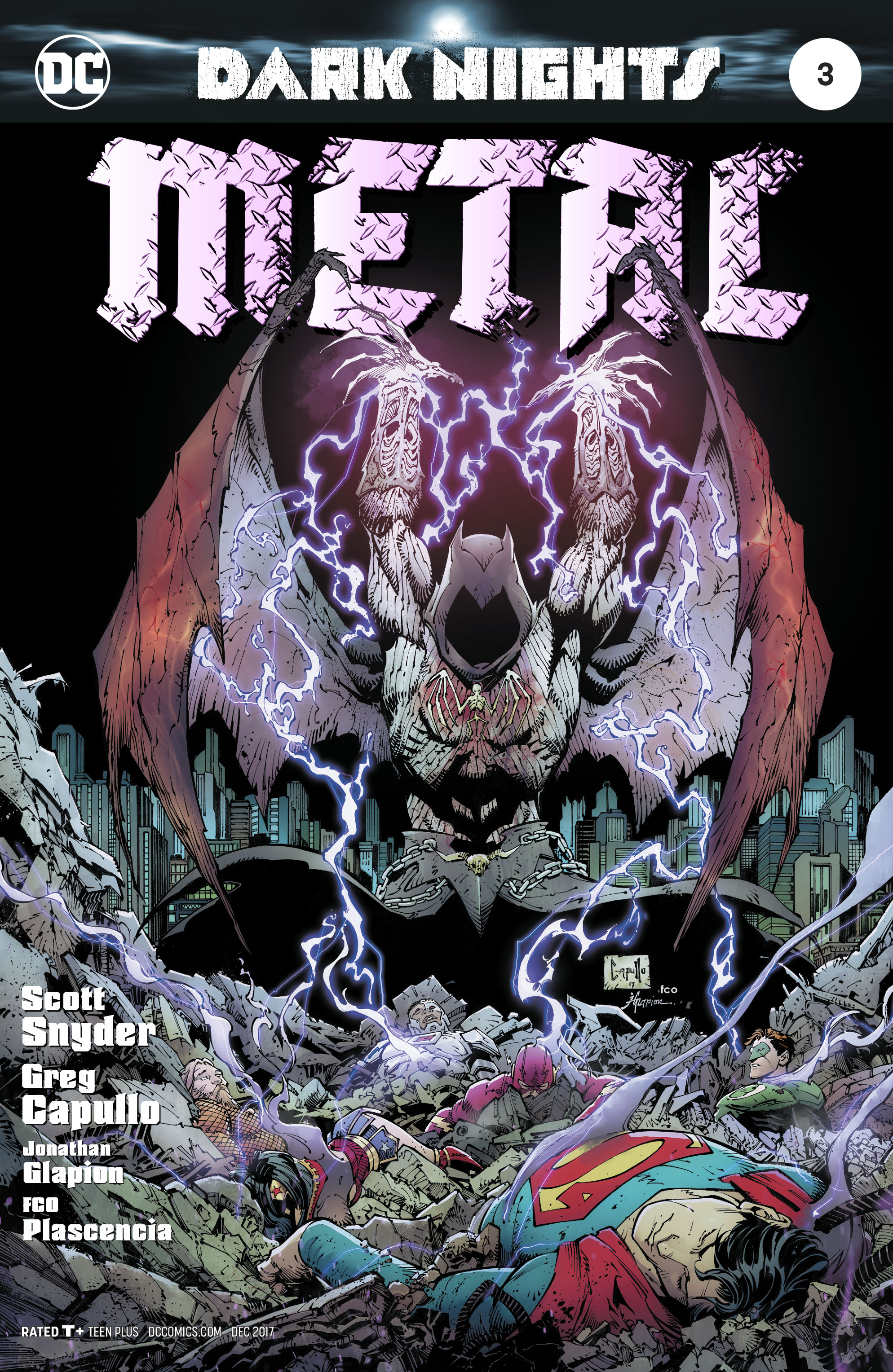
We immediately glommed onto this idea of if we're going to use Duke Thomas at the center of this thing then it really needs to be about what it means to remember the world as it was, and try desperately to get it back there even when you know you can't. That just felt like such a great bit of the mythos that hadn't been fully explored and had never really gotten its time in the sun.
That became the first thing that we glommed onto - this is really going to be something we can talk about. This is a place that we can set a flag and make Tales from the Dark Multiverse: Metal and actual iconic Duke Thomas story. If you were a Duke fan, you're going to get something new out of this book that you've never seen before. Several times over actually.
Kelly: I'm going to contain myself to just two because I think readers will find that almost every page has something that clearly, we were just totally in love with. This book is bonkers in the best way, but for me, it comes down to one word - DRAGONS. That is dragons, my friends.
My personal goal has been to work dragons into the DCU for quite a while now. They don't generally fit. But with Barbatos, we had a pipeline right into the concept of dragons within the DCU. So, one of our concepts was what if this armor does is transform all of our heroes into what we call the dragons of the bat.
If that sounds awesome to you, trust me, it is as awesome as you think it is. It's the coolest ideas for these horrible twisted, monstrous versions of the Justice League, and then hit over to Karl Mostert - our artist on this, who absolutely delivered some of the most bad-ass designs we have ever seen.
Working with him was an absolute dream on this project. Every single page, every single panel is a jaw-dropper. If we could book him for every single DC book we do from here on in, we would do it in a heartbeat. He is turning everything we did up to 11, and we could not have been happier with it.
The other thing I just want to put a quick little hat trick on – a thing I think our editor, Dave Weilgosz, suggested, and that is what happens to the Hall of Justice. We were kind of banding around ideas because obviously this is also going to harken the return of the Batman Who Laughs - one of the deadliest villains in DC's modern age, and we have to deal with that.
So, one of the ideas we had was 'What if he has taken over the Hall of Justice? What does that look like?' Dave came up with a little idea called the Ha of Justice.
Lanzing: I still love it. It just makes me laugh.
Kelly: We all had a good laugh, and then we thought about it and we were like, no, that's perfect. It's that exact tone of can we take this thing that makes you laugh, but also say fuck yeah. So, it propels you into the story. Dave had a measurable impact on this book and guiding it same with Ben Mears, who was also an absolute hero. Together, the full team - I think we delivered something really special that we hope will melt eyeballs of everyone who reads it.
Tales of the Dark Multiverse: Metal #1 goes on sale on December 29, and will be available in print and digitally. Check out our list of the best digital comics readers for Android and iOS devices.
Kat has been working in the comic book industry as a critic for over a decade with her YouTube channel, Comic Uno. She’s been writing for Newsarama since 2017 and also currently writes for DC Comics’ DC Universe - bylines include IGN, Fandom, and TV Guide. She writes her own comics with her titles Like Father, Like Daughter and They Call Her…The Dancer. Calamia has a Bachelor’s degree in Communications and minor in Journalism through Marymount Manhattan and a MFA in Writing and Producing Television from LIU Brooklyn.



